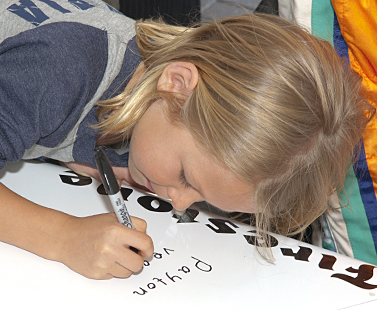Managing diabetes at 200 mph
USF Diabetes Center hosts Indy race car driver Charlie Kimball at a community event launching
a national campaign for insulin delivery options
Charlie Kimball doesn’t let Type 1 diabetes stand in the way of pushing his 1,600 pound, 700-horsepower race car to its 200-plus mph limit.
Kimball, in town to compete in Grand Prix of St. Petersburg, swung by USF Health Morsani Center for Advanced Healthcare this Wednesday to launch a national campaign on options for insulin delivery. The campaign is sponsored by Novo Nordisk, which sponsors the number 83 IZOD IndyCar series race car that Kimball drives.
Kimball was introduced by Dr. Henry Rodriguez, medical director of the USF Diabetes Center. He was greeted by more than a dozen young people with Type 1 diabetes and their parents, who came to hear Kimball, 26, tell his inspiring story. It’s a story about forging a successful career in the highly competitive field of open wheel racing — even with a disease requiring blood sugar testing several times a day, lifelong commitment to insulin injections, and significant lifestyle changes.

IndyCar driver Charlie Kimball with Dr. Henry Rodriguez, director of the USF Diabetes Center, in front of a replica of the race car Kimball will drive in the Grand Prix of St. Petersburg.
The children who attended got to sign a replica of Kimball’s official race car after making a pledge to talk to their health care practitioners about options for best controlling their diabetes. Their parents asked Kimball questions like how much he tests his blood sugar on race day and what special provisions he makes in the cockpit. The kids were more interested in getting Kimball’s autograph, touching his fireproof suit and asking how fast he drives and whether he’s ever crashed.
Kimball is a great role model for kids who worry about what life will be like after a diagnosis of diabetes, Dr. Rodriguez said. “Charlie is a fine example of someone who has taken charge of managing his diabetes while pursuing his dream.”

Payton Veghte, 7, of Clearwater, signs Kimball’s IZOD IndyCar series race car. Payton doesn’t have diabetes, but her brother Christian does. “We say we were all diagnosed… it affects the entire family,” said Payton’s mother Leigh Veghte.
When he was diagnosed with Type 1 diabetes in 2007 after visiting the doctor for an unrelated skin rash, Kimball was worried he might have to abandon his fledgling racing career. He had already bypassed admission to Stanford University after being accepted there to follow his dream to become a racecar driver.
“I knew driving race cars was truly my passion and I didn’t know if diabetes was going to derail it,” he said.
But, he worked closely with his diabetes care team to establish a treatment regimen that fit his needs and allows him to continue competitive racing. Six months after the unexpected diagnosis he returned to the cockpit and claimed a second-place finish in his first race back. Kimball is the first licensed driver with diabetes in the history of IndyCar, and this Memorial Day he will be the first driver with diabetes to compete in the legendary Indianapolis 500.
“I’m living proof that diabetes doesn’t have to slow you down,” Kimball said. “With good care and management you can do anything in life you want — whether it’s driving a race car 200 miles an hour, being an Olympic swimmer or climbing Mount Everest.”

Kimball autographs a photo for some young “fans” who came to USF Health
to hear him tell his story about racing with Type 1 diabetes.
That doesn’t mean the road is easy. It is physically and mentally demanding to maneuver a high-speed car, inches away from other cars, around a track for one to three hours. There’s no question that stress can impact hormones in the body that regulate blood sugar, Dr. Rodriguez said, but Kimball’s meticulous pre-race preparation and constant monitoring of his condition help him compete safely at a high level.
Kimball injects insulin through a pre-filled pen device. Two hours before a race, he checks his blood sugar at 30-minute intervals. It’s the last thing he does before puts on his gloves and dons his helmet. “I’m very proactive. I’m more aware of the nutritional value of what I’m putting in my body and my physical condition – things that drivers without diabetes may take for granted,” he said. “If I do my preparation right, I can focus on winning.”
Inside the car, Kimball wears a sensor patch on his arm that wirelessly transmits his blood sugar readings to a receiver. So, along with all the data about his car’s performance — speed, lap times, oil and tire pressure – Kimball can also see his continuous blood sugar levels from a monitor mounted on his dashboard. If his levels drop, he can sip orange juice through a straw on the inside of his helmet. If blood sugar drops too low, it can lead to weakness, lack of concentration, slower reaction time, and, if severe enough, loss of consciousness.
“Knowledge is an invaluable tool in diabetes management,” Dr. Rodriguez said. “It gives you the ability to determine what you need to do” to prevent potential problems.

Noah, left, and Harrison Holsinger, twins with Type 1 diabetes, attended the community event hosted by the USF Diabetes Center. Below: Noah, diagnosed at age 3, signs the race car. Brother Harrison was diagnosed last year.

That message wasn’t lost on the youngsters who showed up to see Kimball and sign his replica car. Harrison and Noah Holsinger of St. Petersburg, 9-year-old twin brothers with Type 1 diabetes, thought it was “really cool” that Kimball “is not letting his diabetes stop him.” They said they both want to be athletes as well – NFL football players like Jay Cutler (quarterback for the Chicago Bears who has Type 1 diabetes).
Harrison, diagnosed with Type 1 diabetes last year, said his brother Noah, diagnosed five years earlier at age 3, helped alleviate his fears about the disease, including insulin injections. “One day he gave me my shot and I gave him his,” he said.

You can follow Charlie Kimball on Twitter at @racewithinsulin.
For more information about the USF Diabetes Center, visit www.usfdiabetescenter.org.
For more information on the Novo Nordisk’s Drive the Switch campaign, go to www.DrivetheSwitch.com
Video by Amy Mariani, story by Anne DeLotto Baier and photos by Eric Younghans, USF Health Communications

